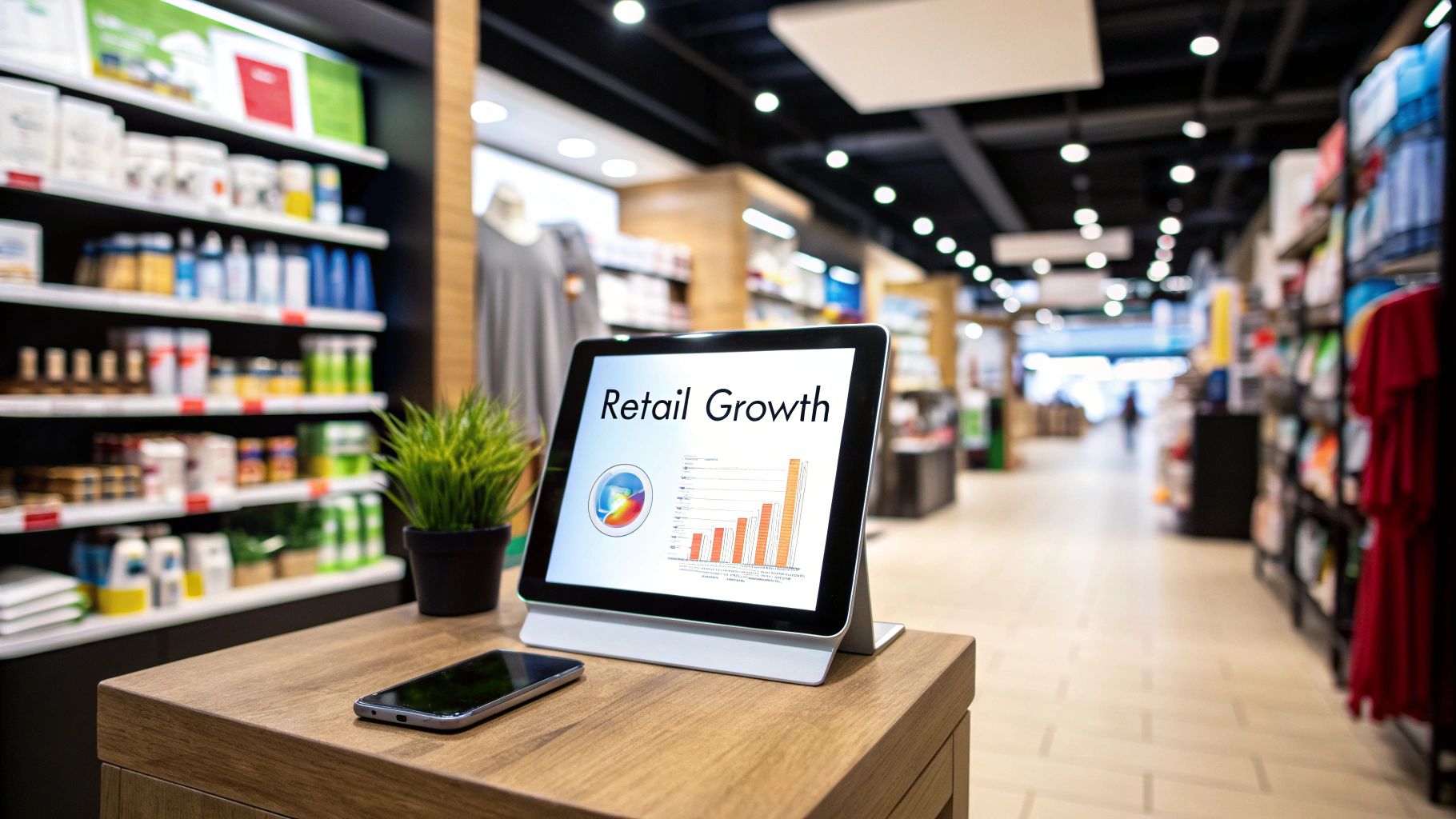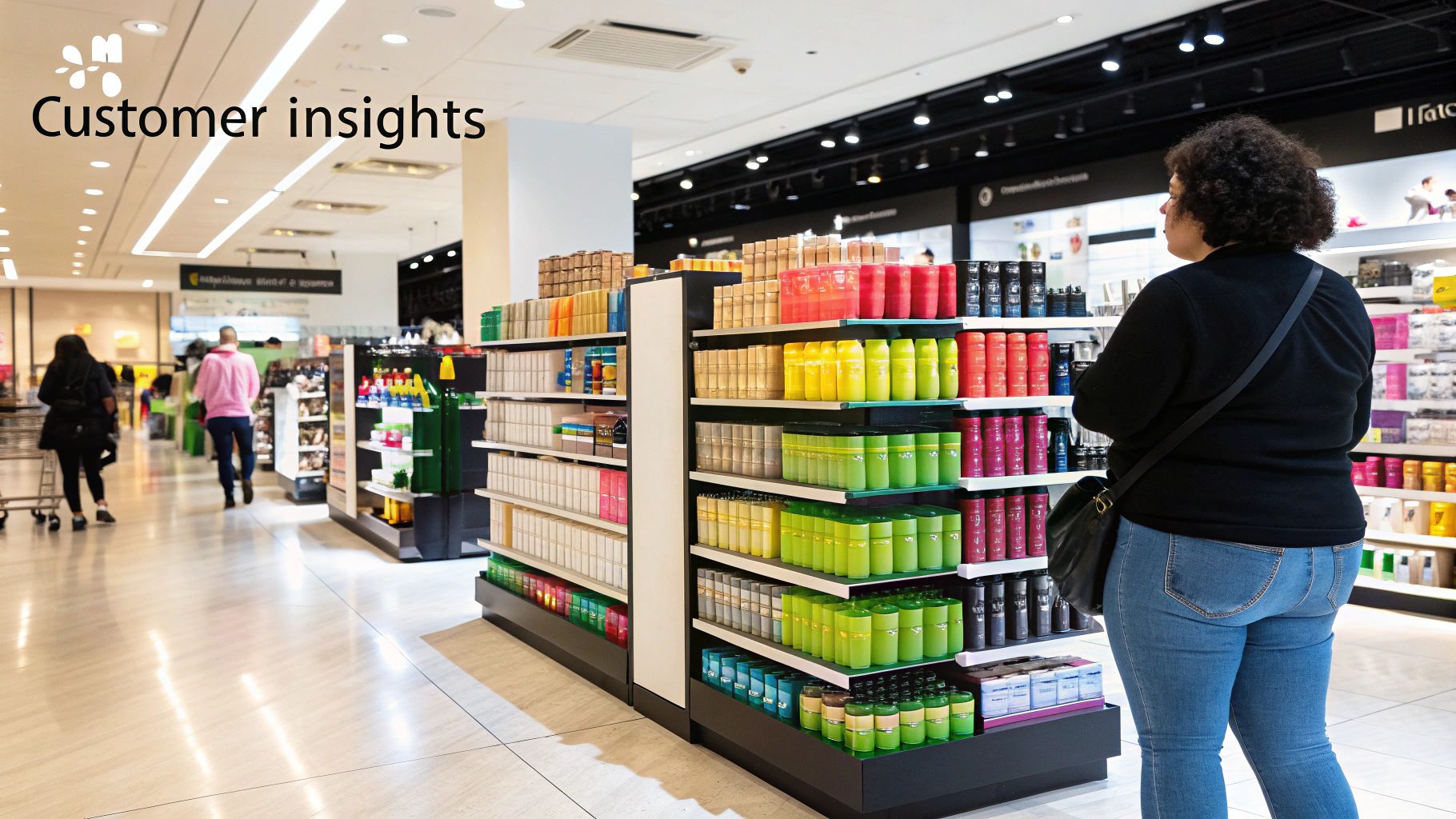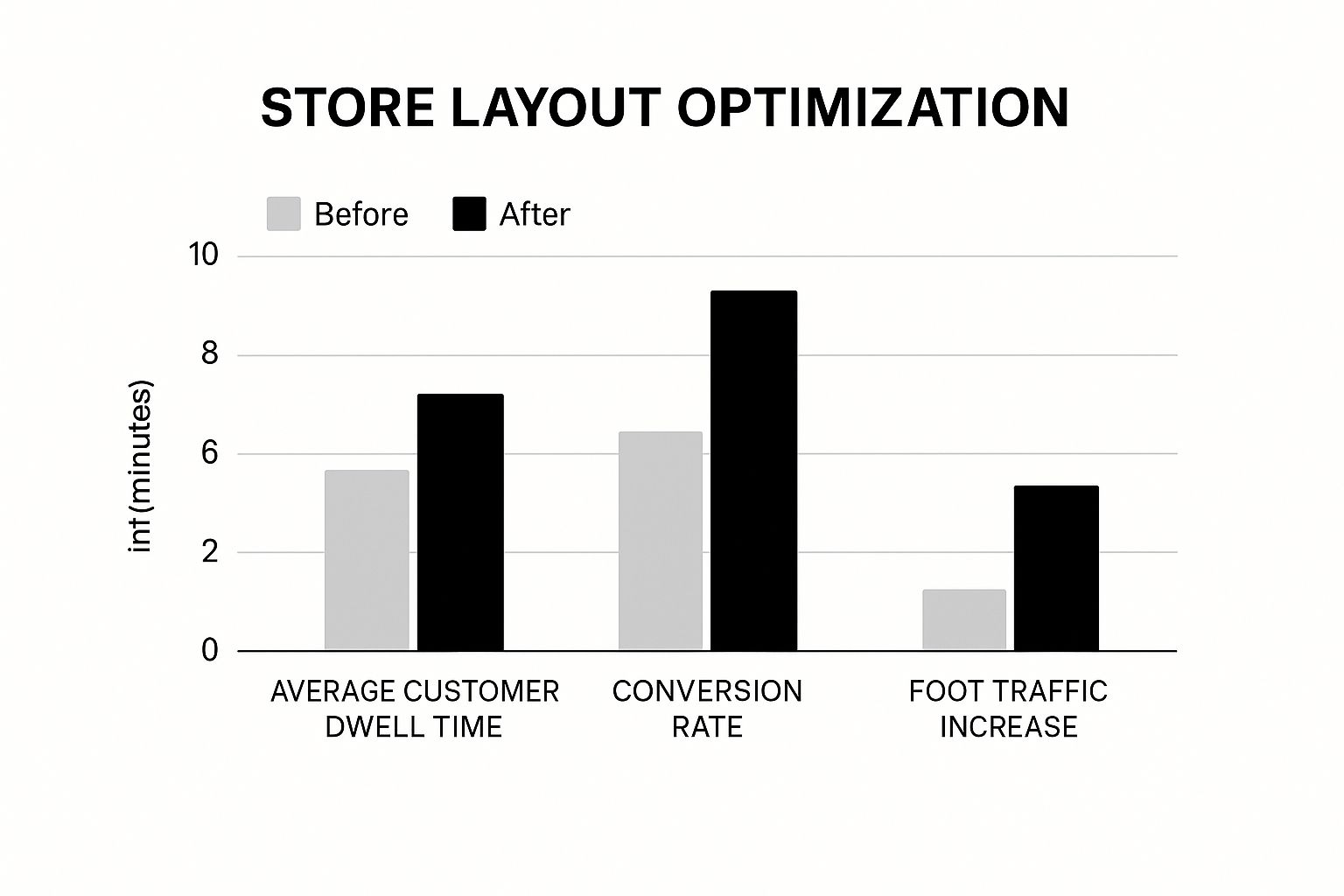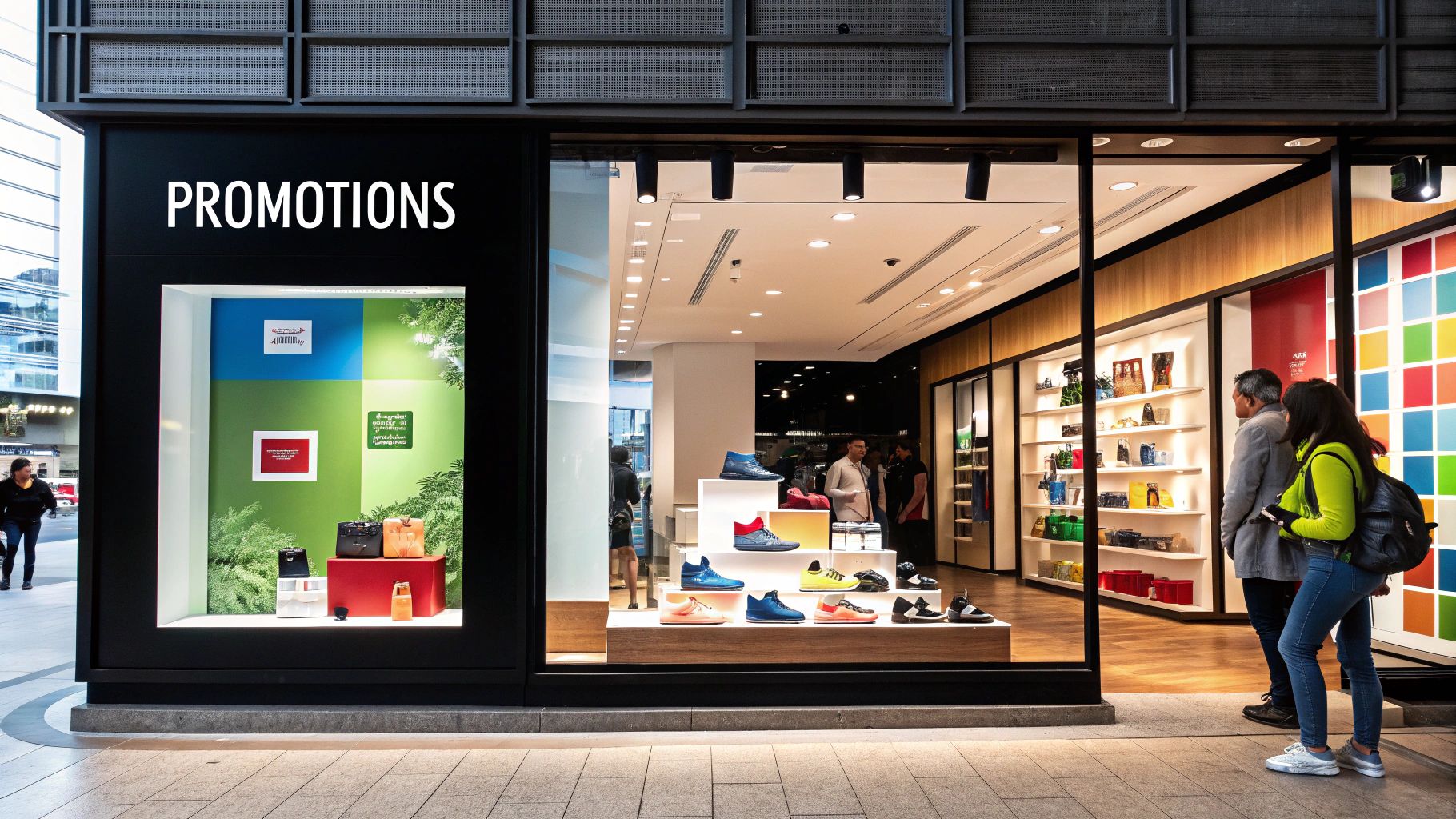Stay Updated with Everything about MDS
Thank you! Your submission has been received!
Oops! Something went wrong while submitting the form.

Chilat Doina
July 26, 2025
Let's be real: growing retail sales isn't about choosing between a cool in-store vibe and a slick website anymore. It's about making them work together. The secret sauce is a simple, yet powerful, mix: nail the in-store experience, dominate your online presence, and then blend them so seamlessly your customers don't even notice. That’s where the magic happens.

The whole "online vs. brick-and-mortar" debate is dead. Smart brands figured out that customers don't think in channels—they just see your brand. The only way to really grow today is to build a world where your physical and digital storefronts are best friends, constantly helping each other out. Some call it "phygital," but it's really just common sense for modern retail.
Think about how people actually shop now. Someone spots your product on Instagram, hops over to your site to check reviews, swings by the store to get a feel for it, and then buys it from their phone on the couch for home delivery. Your job is to make every single one of those touchpoints smooth and enjoyable.
If you want to seriously move the needle on sales, you need to build your strategy on three solid foundations. Nailing just one won't cut it. The real power comes when they all work in concert.
The big idea? Stop thinking about channels as separate buckets. Focus on creating one, unified customer journey that uses the best of both your physical and digital assets to drive sales.
Knowing the theory is great, but putting it into action is what counts. We’ve broken down the key moves you can make within each area to start seeing results—fast. Consider this your cheat sheet for boosting sales across your entire operation.
This guide will walk you through the practical, no-fluff strategies for each pillar. We're talking store layouts, staff training, SEO, smart tech, and everything in between. The table below gives you a quick snapshot of what we'll be focusing on.
By zeroing in on these areas, you'll build a retail model that's not just resilient but also ready to meet—and beat—the expectations of today's savvy shoppers. This is how you set the stage for real, long-term growth.
Your digital storefront is where countless potential customers first meet your brand. It's no longer enough to just have a website; you have to turn it into a powerful, frictionless sales engine. Honestly, one of the most direct ways to boost retail sales on a global scale is by leaning into e-commerce growth.
Just look at the numbers. Total global retail sales were recently projected at a staggering $30.6 trillion. Of that, online sales accounted for $6.56 trillion and are on track to hit $7.4 trillion by 2025. This means nearly one out of every four retail dollars spent worldwide will come from an online purchase. The opportunity is massive.
I've seen it a hundred times: a clunky, confusing, or ridiculously long checkout process is the number one killer of online sales. Every extra click, every unnecessary form field, every surprise fee is another reason for a customer to bail.
Your mission is to make buying from you easier than abandoning the cart. A great first step is to go through your own checkout flow, pretending you're a new customer. How many steps does it take? Are you forcing people to create an account just to give you their money? These are huge friction points.
To truly get this right, you need to dive into comprehensive e-commerce website optimization. It's the core discipline for turning browsers into buyers.
Here’s a quick look at the strategies that move the needle most for online growth.
As the table shows, focusing on these fundamental areas is not just about making small tweaks; it’s about building a solid foundation for sustainable e-commerce success.
Getting the right people to your website is just as crucial as what they experience once they arrive. This is where search engine optimization (SEO) and smart marketing become your best friends. You need to attract shoppers who are actively hunting for the exact solutions your products offer.
A beautiful website is worthless if no one can find it. SEO isn't just about ranking on Google; it's about connecting your products with the people who are already searching for them. That means higher quality traffic and much better conversion rates.
Think about the specific problems your products solve. A person searching for "best running shoes for flat feet" has way more purchase intent than someone just browsing for "shoes." When you create content and product pages that directly answer these specific questions, you capture traffic that is primed and ready to buy.
For a deeper dive, our guide on how to increase ecommerce sales offers more actionable strategies on this front.
The data below shows how optimizing different parts of your site—from speed to checkout—directly impacts the metrics that matter.

It's clear: targeted improvements lead to real gains in both customer engagement and, more importantly, sales.
This isn't negotiable anymore. Well over half of all web traffic now comes from mobile devices. If your site is slow or a pain to use on a smartphone, you are literally throwing sales away.
Even a delay of a few seconds in page load time can cause your conversion rate to crater.
Test your site's speed with a free tool and get to work on the recommendations. The biggest culprits are almost always huge, unoptimized images or clunky third-party scripts. Compressing your images and cleaning up your code are quick wins that can deliver a massive return. A fast, responsive mobile site isn't a luxury—it's a fundamental requirement for selling anything online today.

While a slick website is essential, don't ever underestimate the power of your physical store. It's your single most powerful brand asset. These days, a store can't just be a place to buy things; it has to be a destination.
When you transform your brick-and-mortar space into a genuine experience, you create a direct path to higher sales and a loyal community that money simply can't buy. The goal is to give people a reason to show up that goes beyond just needing a product. It all starts the second they walk through the door.
Think of your store's layout as a carefully planned journey. Where do customers naturally go when they enter? What’s the first thing that catches their eye? A smart layout guides shoppers effortlessly, encouraging them to discover new things and maximizing exposure to your best products. This is pure sales strategy, not just interior design.
One of the biggest mistakes I see is retailers cramming every square inch with merchandise. It creates visual noise and just overwhelms people. Instead, use negative space to make key items pop and to create obvious, easy-to-follow pathways. Pay special attention to your "power wall"—the first wall customers see. This is prime real estate for your newest arrivals or most profitable items.
The real shift in physical retail is moving from a place of transaction to a place of experience. As of July 2024, spending at warehouse clubs and superstores was nearly triple the combined sales of all other general merchandise stores. This proves people will flock to wherever the experience is compelling.
To really nail the art of product presentation, it pays to study what the pros do. You can find some fantastic, in-depth ideas in these visual merchandising guidelines to boost sales and engage customers.
Let's be clear: your sales associates are the human face of your brand. They hold the power to turn a casual browser into a passionate fan or send them walking right out the door. The trick is to empower them to be more than just cashiers. They need to be true brand ambassadors.
This goes way beyond a simple product knowledge quiz. It means deep, meaningful training on:
The most successful retailers I know have figured this out: community drives commerce. By hosting events, workshops, and exclusive in-store experiences, you generate an energy that an online store just can't replicate. You give people a reason to come back, even when they aren't on a mission to buy something specific.
This strategy builds an incredible sense of belonging and turns casual shoppers into a loyal tribe.
Actionable Ideas for In-Store Events:
These events don't need to be huge, expensive productions. The real goal is to build genuine connections, transforming your retail space from just another store into the living, breathing heart of your brand. That's how you boost retail sales for the long haul.
Let's be real: technology isn't just a "nice-to-have" in retail anymore. It's the engine driving modern growth. For sellers who get it, smart tech isn't about chasing shiny objects. It's about crafting deeply personal experiences that customers actually love—and that directly pad your bottom line.
And this isn't some far-off fantasy reserved for megacorporations. Retailers of all shapes and sizes are using these tools right now to build smarter, more profitable businesses. Let's dig into the tech that’s actually delivering a real return.
One of the most potent uses of artificial intelligence in e-commerce has to be the recommendation engine. Think of it as your star salesperson, working around the clock on your website, predicting what each customer is going to want next. These systems look at everything—browsing history, past purchases, what other shoppers bought—to serve up product suggestions that just make sense.
This goes way beyond the tired, generic "You might also like..." banner we've all seen a million times. A properly tuned AI can seriously pump up your Average Order Value (AOV) by making smart, in-the-moment suggestions. For instance, if someone adds a high-end camera to their cart, the AI knows not to just suggest other cameras. It's smart enough to recommend the exact memory card, the right compatible lens, and a protective case that wraps up the whole purchase.
A great recommendation isn't just an upsell; it's a genuine service. When you show a customer products they'll truly love or actually need, you're making their life easier. A bigger sale is just the natural result of a better experience.
There's a reason these tools are everywhere. Something like 80% of retailers worldwide are expected to be using AI. The data backs it up, with studies showing that smart recommendations can lift sales by anywhere from 10% to 30%. If you want to dive deeper into how tech is reshaping the industry, check out the latest retail industry statistics on Bizplanr.ai.
One of the oldest hurdles in online shopping has always been the fact that you can't touch or feel the product. Augmented Reality (AR) is brilliantly dismantling that barrier, especially for businesses in fashion, furniture, and beauty.
AR lets customers use their smartphone cameras to see how a product looks in their space or on them. Just imagine a customer being able to point their phone at their living room and see exactly how that new sofa will fit. Or trying on a dozen lipstick shades without making a mess or leaving their house.
This isn't just a cool gimmick; it has a massive impact on the business:
The global market for AR in retail is already sitting at around $19.9 billion, which shows just how much this technology has been embraced and how well it works.
Nothing torpedoes a sale quicker than a dreaded "out of stock" notice. Thankfully, smart tech can also work its magic behind the scenes to make sure poor inventory management never costs you a customer. This is an area where AI truly shines, turning a logistical nightmare into a serious competitive edge.
AI-powered systems can chew through historical sales data, spot current trends, account for seasonality, and even factor in outside events like upcoming holidays or weather forecasts to predict future demand with scary accuracy.
Here's How AI Inventory Management Gets It Done:
By getting your stock levels just right, you’re guaranteeing that when a customer is ready to buy, you're ready to sell. This kind of backend intelligence is every bit as critical for boosting sales as any flashy, customer-facing tech.

Let's get one thing straight: your customers don't think in terms of "online" versus "in-store." To them, it's all just shopping. They see your brand, and they expect a single, smooth experience whether they're on their phone, on their laptop, or walking through your front door.
Building that unified journey is the heart of a modern omnichannel sales strategy. It’s all about erasing the lines between your digital and physical worlds. When you nail this, you don't just make buying easier; you build a more resilient business and seriously boost the lifetime value of every customer.
"Buy Online, Pick Up In-Store" (BOPIS) is no longer a perk—it's an expectation. The logic is a winner: it blends the convenience of online browsing with the instant reward of same-day pickup. Getting this right is a massive sales lever.
The execution has to be flawless. When a customer walks in, their order needs to be ready and waiting at a clearly marked counter. A clunky pickup process with long lines or confused staff kills the whole vibe and erodes trust.
Then you have its cousin, "Buy Online, Return In-Store" (BORIS). An easy return policy is a surprisingly potent sales tool. A difficult return can turn a customer off your brand for good. But a smooth, no-questions-asked in-store return creates a positive memory and, just as importantly, brings them back into your physical store. This gives your team another shot at turning that refund into an exchange or even a bigger sale.
Your brick-and-mortar locations are more than just showrooms. They are strategic assets that can turbocharge your e-commerce fulfillment. By treating your stores like "mini-distribution centers," you can ship online orders from the location closest to the customer.
This approach delivers two huge wins for your sales:
If you want to dig deeper into the nuts and bolts, check out our guide on building a successful omnichannel retail strategy. It breaks down the operational side of making all these pieces work together.
The goal is to make your entire inventory available to every customer, everywhere, all the time. An item sitting on a shelf in one store should be just as sellable online to a customer across the country as it is to someone walking through the door.
Real omnichannel success runs on data. You have to connect the dots between what a customer does on your website and what they do in your stores. When you have a single, unified view of each customer, you can create genuinely personalized experiences that drive sales.
Think about these scenarios:
This isn't just a tech gimmick. It's what makes customers feel like your brand actually gets them.
Key Data Points to Unify:
By weaving these channels together, you create a powerful feedback loop where every interaction makes the next one smarter. This is how you not only increase sales today but also build the kind of deep-seated loyalty that fuels growth for years to come.
As you start to grow your retail business, some questions just keep popping up. It's totally normal. Here, we're cutting through the fluff to answer the most common things we hear from retailers trying to scale up.
For a smaller shop, the quickest wins almost always come from a smart mix of super-local digital marketing and genuinely great in-store service. You don't need a huge budget to see a difference, either.
First things first: get your Google Business Profile dialed in. This is non-negotiable for anyone who wants to capture local search traffic. Make sure your hours are correct, upload high-quality photos of your store and products, and get proactive about asking for customer reviews. A strong local presence is basically free advertising.
At the same time, spin up a small, tightly-targeted social media ad campaign. You're not trying to reach everyone—just promote one compelling offer to a specific group of people right in your area. Back in the store, train your team on how to upsell and cross-sell in a way that feels helpful, not pushy.
A simple, "Have you seen the matching gloves that go with that scarf?" can seriously lift your average transaction value. The key is to frame it as serving the customer better, not just squeezing more money out of them.
Finally, roll out a basic loyalty program. It can be as simple as a punch card. This gives customers an immediate reason to come back, which boosts your repeat business and provides a quick, noticeable sales lift.
Success is all about tracking the right numbers—your Key Performance Indicators (KPIs). What gets measured gets managed, so you need to know which metrics actually move the needle for your business.
For your online store, the vital signs you absolutely have to watch are:
For your brick-and-mortar location, your focus shifts slightly:
The most important step here is to get a clear baseline before you change anything. Use tools like Google Analytics for your e-commerce site and the built-in reporting in your Point of Sale (POS) system. If you aren't regularly looking at these numbers, you're just guessing at what's working and what’s a waste of money.
This is the classic retail dilemma, isn't it? While chasing new customers is exciting, the data doesn't lie: keeping your existing ones is far more profitable. Repeat customers spend more over time and are way more likely to become your best marketers through word-of-mouth.
But the best strategy isn't "either/or." It's a balanced "both/and" approach.
You have to dedicate real resources to making your current customers feel valued. That means investing in smart loyalty programs, personalized email campaigns, and solid post-purchase support. These efforts are the bedrock of a healthy business. For a deeper dive, you can explore specific strategies for improving e-commerce customer retention to keep your best buyers coming back for more.
At the same time, you need to set aside a specific, defined part of your budget for acquiring new customers through channels like SEO and targeted ads. The goal is to build a flywheel: you attract new buyers with smart marketing, and then you turn them into loyal fans with an amazing experience.
Join the Ecom Entrepreneur Community for Vetted 7-9 Figure Ecommerce Founders
Learn MoreYou may also like:
Learn more about our special events!
Check Events